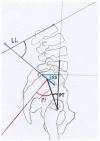Analysis of the Spinopelvic Parameters in Patients with Fragility Fractures of the Pelvis
- PMID: 37445480
- PMCID: PMC10342505
- DOI: 10.3390/jcm12134445
Analysis of the Spinopelvic Parameters in Patients with Fragility Fractures of the Pelvis
Abstract
Background: We investigated the spinopelvic parameters of lumbar lordosis (LL), pelvic incidence (PI), pelvic tilt (PT) and sacral slope (SS) in patients with fragility fractures of the pelvis (FFPs). We hypothesized that these parameters differ from asymptomatic patients.
Methods: All patients treated for FFPs in a center of maximal care of the German Spine Society (DWG) between 2017 and 2021 were included. The inclusion criteria were age ≥ 60 years and the availability of a standing lateral radiograph of the spine and pelvis in which the spine from T12 to S1 and both femoral heads were visible. The baseline characteristics and study parameters were calculated and compared with databases of asymptomatic patients. The two-sample t-Test was performed with p < 0.05.
Results: The study population (n = 57) consisted of 49 female patients. The mean age was 81.0 years. The mean LL was 47.9°, the mean PT was 29.4°, the mean SS was 34.2° and the mean PI was 64.4°. The mean value of LLI was 0.7. LL, LLI and SS were significantly reduced, and PI and PT were significantly increased compared to asymptomatic patients.
Conclusions: The spinopelvic parameters in patients with FFPs differ significantly from asymptomatic patients. In patients with FFPs, LL, LLI and SS are significantly reduced, and PI and PT are significantly increased. The sagittal spinopelvic balance is abnormal in patients with FFPs.
Keywords: FFPs (fragility fractures of the pelvis); lumbar lordosis index; osteoporosis; pelvic incidence; pelvic tilt; sacral slope; sagittal balance; spinopelvic parameters.
Conflict of interest statement
The authors declare no conflict of interest.
Figures







Similar articles
-
The impact of spinopelvic morphology on the short-term outcome of pedicle subtraction osteotomy in 104 patients.J Neurosurg Spine. 2017 Jul;27(1):74-80. doi: 10.3171/2016.11.SPINE16601. Epub 2017 Apr 28. J Neurosurg Spine. 2017. PMID: 28452632
-
Sagittal Parameters of Spine-Pelvis-Hip Joints in Patients with Lumbar Spinal Stenosis.Orthop Surg. 2022 Nov;14(11):2854-2862. doi: 10.1111/os.13467. Epub 2022 Sep 20. Orthop Surg. 2022. PMID: 36125192 Free PMC article.
-
Association of Sagittal Spinopelvic Realignment with Correction in Lower Lumbar Lordosis after Surgical Treatment in Degenerative Lumbar Scoliosis.Orthop Surg. 2021 Oct;13(7):2034-2042. doi: 10.1111/os.13138. Epub 2021 Sep 24. Orthop Surg. 2021. PMID: 34559468 Free PMC article.
-
Spinopelvic sagittal imbalance as a risk factor for adjacent-segment disease after single-segment posterior lumbar interbody fusion.J Neurosurg Spine. 2017 Apr;26(4):435-440. doi: 10.3171/2016.9.SPINE16232. Epub 2017 Jan 6. J Neurosurg Spine. 2017. PMID: 28059683
-
The effect of ethnicity on the age-related changes of spinopelvic characteristics: a systematic review.Bone Joint Res. 2023 Apr 1;12(4):231-244. doi: 10.1302/2046-3758.124.BJR-2022-0335.R1. Bone Joint Res. 2023. PMID: 37051815 Free PMC article.
Cited by
-
Long-Term Follow-Up after Iliosacral Screw Fixation of Unstable Pelvic Ring Fractures.J Clin Med. 2024 Feb 14;13(4):1070. doi: 10.3390/jcm13041070. J Clin Med. 2024. PMID: 38398383 Free PMC article.
-
Bilateral Iliosacral and Transsacral Screws Are Biomechanically Favorable and Reduce the Risk for Fracture Progression in Fragility Fractures of the Pelvis-A Finite Element Analysis.Bioengineering (Basel). 2025 Jan 1;12(1):27. doi: 10.3390/bioengineering12010027. Bioengineering (Basel). 2025. PMID: 39851301 Free PMC article.
References
LinkOut - more resources
Full Text Sources
Research Materials
Miscellaneous

